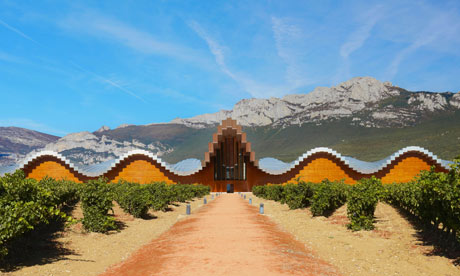He is the genius behind some of the world's most spectacular bridges, museums and airports, but Spanish architect Santiago Calatrava cannot plug a leaking roof, according to a client who is demanding he contribute to the €2m (£1.7m) needed to pay someone else to do the job. A dozen years after Calatrava built the spectacular Ysios winery in the rainy Alava region of northern Spain, the building's dramatic, undulating roof continues to let in the damp.
Now Domecq, the owner of the winery, has said it is fed up with the botched attempts of Calatrava's original builders at fixing the roof and wants money from them so that it can bring in fresh architects and engineers to design a new one.
An expert's report that accompanies a writ lodged at a court in Vitoria claims that the roof, made of wood and aluminium, has never managed to keep the rain out. The firm pledges to maintain the original outline designed by Calatrava – an architect and engineer sometimes compared with fellow Spaniard Antoni Gaudí – but says that the leaks are damaging its image.
The row comes on the top of complaints in Calatrava's home city of Valencia about the slowly wrinkling, ceramic outer skin of the city's emblematic Palau de Les Arts, where tiles have started to shake loose.
Opposition politicians in Valencia claim that the overall budget for his spaceship-like arts and science complex in the city has quadrupled to €1bn – with almost €100m for the architect's firm. They have demanded that Zurich-based Calatrava, who responded that "his honour was wounded", give some of the money back.
"It has not just put Valencia on the map, but is the second-most visited cultural centre in Spain, after the Alhambra," the architect once declared.
He is also on record as saying that his fees for various projects in the city were perfectly reasonable.
Yet another row, this time with Italian authorities, has seen doubts raised about the cost of his bridge over the Grand Canal in Venice – the first bridge to be built there in 75 years. Authorities now demand that he and others involved cover some €4m of spending, while Il Giornale newspaper recently claimed the city had received some 5,000 complaints from those who have used it, including some who also claim it is too slippery.
In northern Bilbao, meanwhile, his Zubizuri bridge over the river Nervión has been dubbed the "wipe-out" bridge, because of the number of people who have slipped and fallen. Authorities there have also reportedly had to spend up to €6,000 a year replacing broken tiles.
The mayor of Bilbao, Iñaki Azkuna, who lost a case against him after authorities altered the original design of his bridge, once declared: "I'm fed up with the dictatorship of Calatrava." In Oviedo a court has ordered that the architect and construction firms involved in building a conference hall there should pay €3m to the insurance firm after part of the structure collapsed during building.
The Oviedo hall's infamous, huge mechanical visor has never worked because of problems with its hydraulics. Calatrava is currently battling the building's owners through the courts after they blamed him and refused to pay his full fees.
But for every Calatrava building that gets into trouble, there are several that survive without creating polemic. They include two bridges in Dublin and Manchester, railway stations in Lisbon, Liege and Lyon and buildings in New York and Milwaukee.
Calatrava did not respond to questions sent to his Zurich office.
Related Stories
| May 8, 2012
Skanska USA hires Zamrowski as senior project manager
In his new role at Skanska, Zamrowski will serve as the day-to-day on-site contact for select Pennsylvania-based projects during all phases of construction.
| May 8, 2012
Morgan/Harbour completes three projects at Columbia Centre
Projects completed on behalf of property owner, White Oak Realty Partners, LLC, Pearlmark Realty Partners, LLC and Angelo Gordon & Co.
| May 7, 2012
4 more trends in higher-education facilities
Our series on college buildings continues with a look at new classroom designs, flexible space, collaboration areas, and the evolving role of the university library.
| May 7, 2012
Best AEC Firms: MHTN Architects nine decades of dedication to Utah
This 65-person design firm has served Salt Lake City and the state of Utah for the better part of 90 years.
| May 7, 2012
2012 BUILDING TEAM AWARDS: TD Ameritrade Park
The new stadium for the College World Series in Omaha combines big-league amenities within a traditional minor league atmosphere.
| May 7, 2012
2012 BUILDING TEAM AWARDS: Fort Belvoir Community Hospital
A new military hospital invokes evidence-based design to create a LEED-certified facility for the nation’s soldiers and their families.
| May 7, 2012
2012 BUILDING TEAM AWARDS: Audie L. Murphy VA Hospital
How a Building Team created a high-tech rehabilitation center for wounded veterans of the conflicts in Iraq and Afghanistan.
| May 3, 2012
2012 BUILDING TEAM AWARDS: Rush University Medical Center
This fully integrated Building Team opted for a multi-prime contracting strategy to keep construction going on Chicago’s Rush University Medical Center, despite the economic meltdown.
| May 3, 2012
U of Michigan team looking to create highly efficient building envelope designs
The system combines the use of sensors, novel construction materials, and utility control software in an effort to create technology capable of reducing a building’s carbon footprint.



















